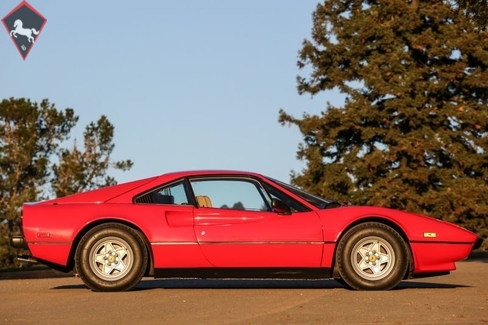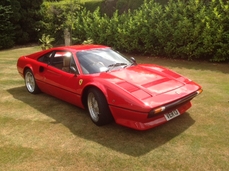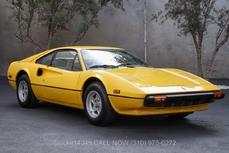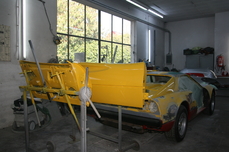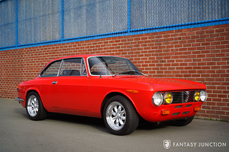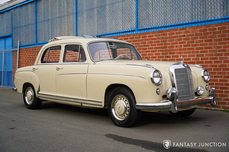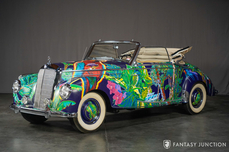Ferrari 308 GTB 3.0 Liter V8 no. 02292 1976
Allgemeine Beschreibung :
1976 Ferrari 308 GTB
s/n 20435, eng. no. 02292
Rosso Corsa with Tan Interior
Introduced in 1975 at the Paris Auto Salon, Pininfarina’s take on the 308 revealed a more curvaceous and exotic looking car than Bertone’s 308 GT4 which preceded it. Pininfarina designer Leonardo Fioravanti, having already designed many of Ferrari's most celebrated cars including the Daytona, the 206/246 Dino, and Berlinetta Boxer, captured a taut new energy and
dynamism in the 308. As a replacement for the 246, the 308 became a new market maker for Ferrari. The 308 styling was dramatic and beautiful, which earned it a place in television shows and movies over the next decade, cementing it as one of the most iconic and recognizable Ferraris made.
Mechanically, the earliest cars featured the same layout of the GT4, including the transversely mounted 3.0 liter quad-cam V8 with four twin-choke Weber carburetors. Ferrari’s characteristic exploration of innovative technology led them to produce the first 308s in fiberglass, but increased demand for the car, coupled with manufacturing challenges of lower volume fiberglass construction methods, caused Ferrari to change production to with steel bodies after the first 100 or so cars. During this transition period, construction of very few steel bodied cars included carbureted engines and early period design details. Throughout its decade of production iterations, the 308 advanced Ferrari into new territories, establishing the brand in a wide range of unchartered markets while becoming more sought for their enjoyable driving traits and exceptional design.
This particular example is a rare, early steel bodied carbureted car, manufactured November 1976, and specified for US delivery. According to the serial number, the car appears to have been one of the few steel bodied cars constructed during the transition period from fiberglass to steel bodies, while still retaining the highly desirable carbureted engine. Unlike the manufacturing inconsistencies often seen in fiberglass surfacing, this steel body retains a refined finish and excellent panel gaps, set off by the thin European front bumper, fit to the car by a previous owner, and early series details. The current owner had a major engine service (including timing belt) by noted Ferrari specialist Mike Spencer roughly 500 miles ago in March 2015, also adding Michelin XWX tires at that time.
Today, this Ferrari 308 presents a confident and sound exterior look and stance, ready for driving. The paint shows light swirling, some minor surface imperfections, and one small area of paint checking on the passenger side quarter panel. The body is very nice overall, with a bubble or two in each door skin, and a few more in the splash areas behind the wheels. Close examination reveals that the car was originally painted “Fly Yellow” when originally delivered. Glass, emblems, and black trim pieces have been properly cared for, showing some imperfections in a few areas when studied up close.
Using the clever early 308 finger latches, the doors open and shut with a tight and crisp latch on both sides. Hood and deck lid open and close with ease. Both contact surfaces have clean rubber surrounds with very minor material compression with some areas showing signs of age. The wheels have been properly maintained with no major curb rash and nice silver sheen. Tires are in excellent order and give the car a proper vintage stance.
Inside the cabin, the contrasting black and tan interior displays the characteristically purposeful layout of the 308 design. This interior black and tan color combination against the red exterior truly highlights the delightful interior details in true Ferrari fashion. The bright instruments, shifter, and switch pieces come to life against the black and tan finishes. The tan leather seats, accented with touches of black, appear to be original leather based on the clean and proper surface patina. The dash and padding, steering wheel, and instruments are all preserved with very good finishes and only minor imperfections, which collectively add to the honest character of the interior. In all, the interior of the car presents cohesively with a pleasant look and feel surrounding occupants with an authentic atmosphere of the 70s.
The carbureted V8 engine and engine compartment are clean and cosmetically well-preserved, with finishes that remain factory specified (aside from red cam covers), slightly dulled in a few areas, honestly indicating the look and feel of an early carbureted car. The red cam covers are an aesthetic touch against the black air filter and other correct factory finishes. The rear zipper compartment appears to have been properly replaced as it zips smoothly open and shut, creating a taut cover for the luggage compartment with no sagging across the rear, concealing clean black carpeting. Up front, the storage compartment is also tidy and correct, displaying largely original components and finishes including a cast spare wheel indicative of early 308 origins. The undercarriage has not been detailed and reveals evidence of use in a few places, but no obvious structural or mechanical issues.
The 3.0 liter engine jumps to life with no hesitation when started using the proper procedure for a carbureted car. The car performs as one might expect with a delight and response consistent with the Weber fed engine. The early carbureted cars are preferred by enthusiasts in part for their excellent response and driver feedback, but also for the added horsepower and glorious noises. This car displays excellent carburetion. Braking and shifting are smooth and effortless delivering a driving experience that encompasses enjoyable touring or carving mild mountain roads. The GTB truly brings out the best of the Ferrari 308 design, as only an early car with these specifications can deliver thanks to their more powerful and characterful engines and the rigidity afforded by the Berlinetta platform. Original (now removed but included with the car) emissions components, a tool roll with a partially complete set of tools, jack, spare belts, and tire tools are all included with the sale.
For anyone who seeking a rare carbureted Ferrari 308 GTB, this early steel bodied car is a well-maintained example offering the enthusiast a chance to drive and enjoy a fun and cosmetically satisfying car, with all the beauty and charisma of these early cars, just as Ferrari intended when they originally built these exciting mid-engine sports cars.
Due to California state emissions requirements, this car must be sold to an out of state buyer or California dealer.
http://fantasyjunction.com/cars/2182-Ferrari-308%20GTB-2.9%20Liter%20V8
1976 Ferrari 308 GTB 3.0 Liter V8 no. 02292 is listed verkauft on ClassicDigest in Emeryville by Fantasy Junction for $79500.
Fakten der Auto
Karosserietyp : Auto Marke : Ferrari Modell : 308 GTB Ausführung : 3.0 Liter V8 no. 02292 Hubraum : 2.9 Modelljahr : 1976 Lage : Emeryville
Verkauft
Angaben Zum Verkäufer
Verkauft
People who viewed this Ferrari 308 GTB also viewed similar Ferrari listed at ClassicDigest
Other cars listed for sale by this dealer
über Ferrari
Der erste Ferrari Straßenauto wurde die 125 S im Jahr 1947 eingeführt und angetrieben von einem 1,5 l-V12-Motor, oder?Nun, es ist nicht ganz so einfach, Ferrari in der Tat produzieren e Tipo 815, 1940 Tipo 815 wurde von Ex-Alfa Romeo Ingenieure Alberto Massimino und Vittorio Bellentani und von Enrico Nardi gesellschafts Enzos aber juristische Probleme mit dem ehemaligen Partner Alfa Romeo entwickelt verhindert Ferrari vom Start der Ferrari marque an diesem Punkt.
Enzo tat produzieren eine Reihe von feinen Straßenautos in den 50er und 60er Jahren, sondern sie lediglich zu seiner wahren Leidenschaft Renn, Wetter GT / Sportwagen oder Grand Prix finanzieren waren. Die 50-Jährige sah die Geburt von denkwürdigsten Autos Ferrari 250 GTB (Tour de France) 250 Testa Rossa, 250 GT SWB, nur um einige zu nennen.
Unter der Oberflächenspannung wurde aber wächst. In November 1961 langjähriger Vertriebsleiter Girolamo Gardini machte ein Ultimatum an Enzo: Wenn die Spannungen weiter, er das Unternehmen verlassen würde. Als Ergebnis wurde Gardini verdrängt sowie Scuderia Ferrari Manager Romolo Tavoni, Chefingenieur Carlo Chiti, experimentelle Sportwagen-Entwicklungschef Giotto Bizzarrini, und eine Reihe von anderen, die von ihnen stand.
Ohne Chiti und Bizzarrini die Entwicklung dessen, was war es, das die meisten Inbegriff Ferrari geworden und heute der weltweit teuerste Auto, 250 GTO wurde auf einem Drehpunkt. 250 GTO Projekt wurde von einem jungen Ingenieur Mauro Forghieri und langjähriger Renn Klempner Sergio Scaglietti, die in abgestuften und über das Programm mit bekannten Ergebnissen nahm gespeichert.
Neben 250 GTO, Ferrari launced solche Meisterwerke wie 250 LM, 250P, 275 GTB, 365 GTB / 4 "Daytona" Während der 60er Jahre
Durch den Erfolg der späten 60er Ferrari Prototypen 'zu einem plötzlichen Stillstand kam durch einen neuen Konkurrenten, GT40. Ford drehte sich zu Lola, einen Ferrari zu schlagen Fern racer produzieren nach Enzo hatte den Deal mit Henry Ford II verschärfen absolut vor Wut kochen abgeschnitten. Die Zusammenarbeit zwischen Ford und Lola erstellt den mächtigen Ford GT40, die Ferrari gab einige schwere Treffer in Le Mans 24 kommen.
Bis Ende der 60er Jahre FIAT gekauft: 50% des Unternehmens, beginnend eine Entwicklung, die zu einer neuen Massenware Ära der Ferraris geführt hat.
Ob Sie verkaufen oder auf der Suche nach einem klassischen Ferrari www.classicdigest.com ist der site heraus zu überprüfen.
